Direct and Indirect Impacts of Vegetation on Building Comfort: A Comparative Study of Lawns, Green Walls and Green Roofs
Abstract
:1. Introduction
2. Methodology
2.1. The SOLENE-Microclimat Model
- -
- LW radiation exchanges using the radiosity method;
- -
- conduction heat transfer and thermal storage in walls and soil;
- -
- airflow and convective exchanges through the coupling with a computational fluid dynamics (CFD) code.
- -
- Evapotranspiration, i.e., latent heat flux due to transpiration and evaporation of water contained in both the plants and substrate.
- -
- Radiation: the foliage layer modifies both short-wave (SW) and LW radiation; moreover, it reflects, absorbs and transmits a portion of the SW radiation to the shaded surface area. In covering the surface, this layer exchanges LW radiation with the surrounding surfaces, as well as with the surface being covered.
- -
- Convection: the foliage layer is rough and modifies the near surface airflow, thus implying a modification to the heat transfer.
2.2. The Studied Urban District
2.3. The Studied Building
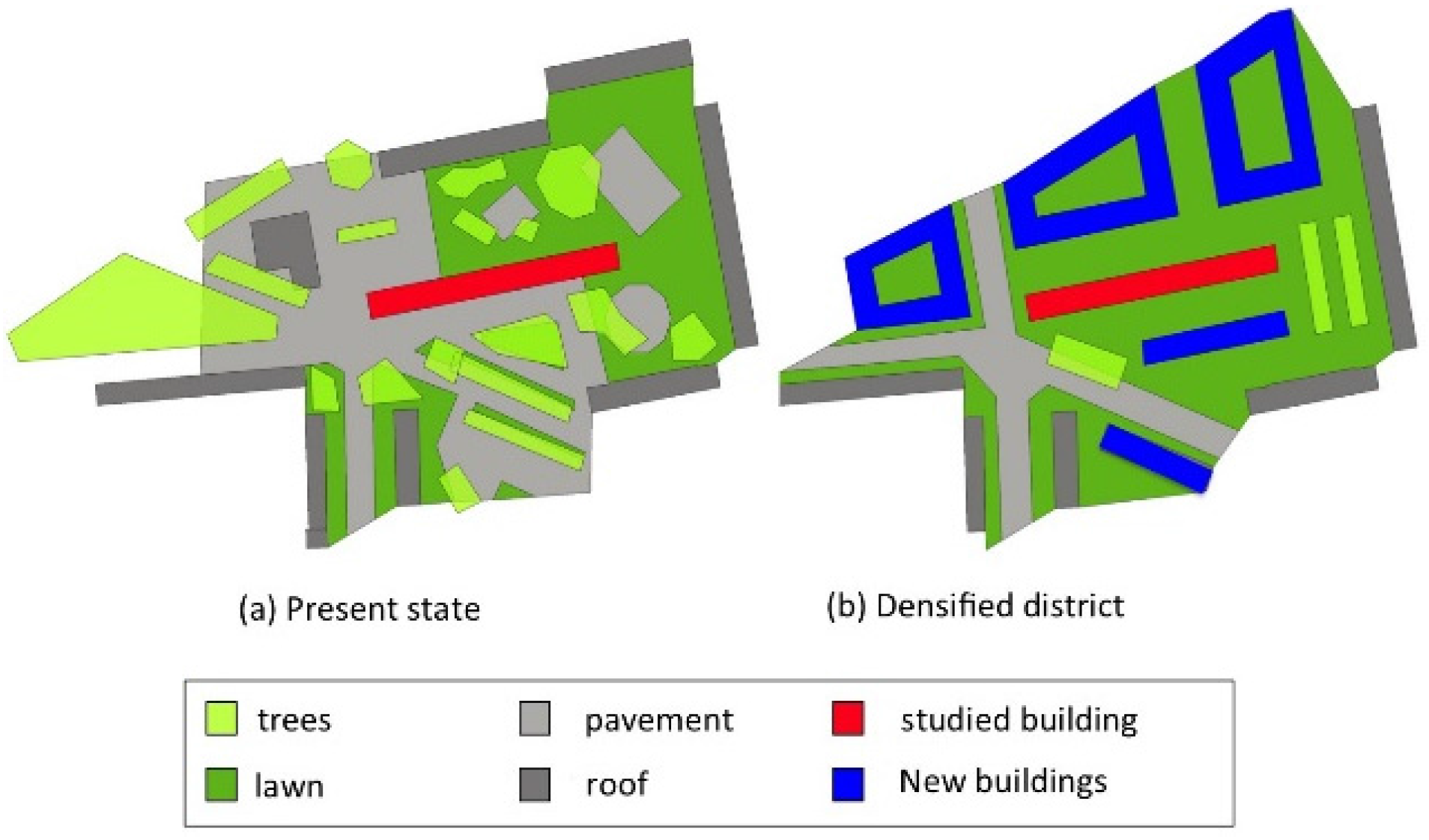
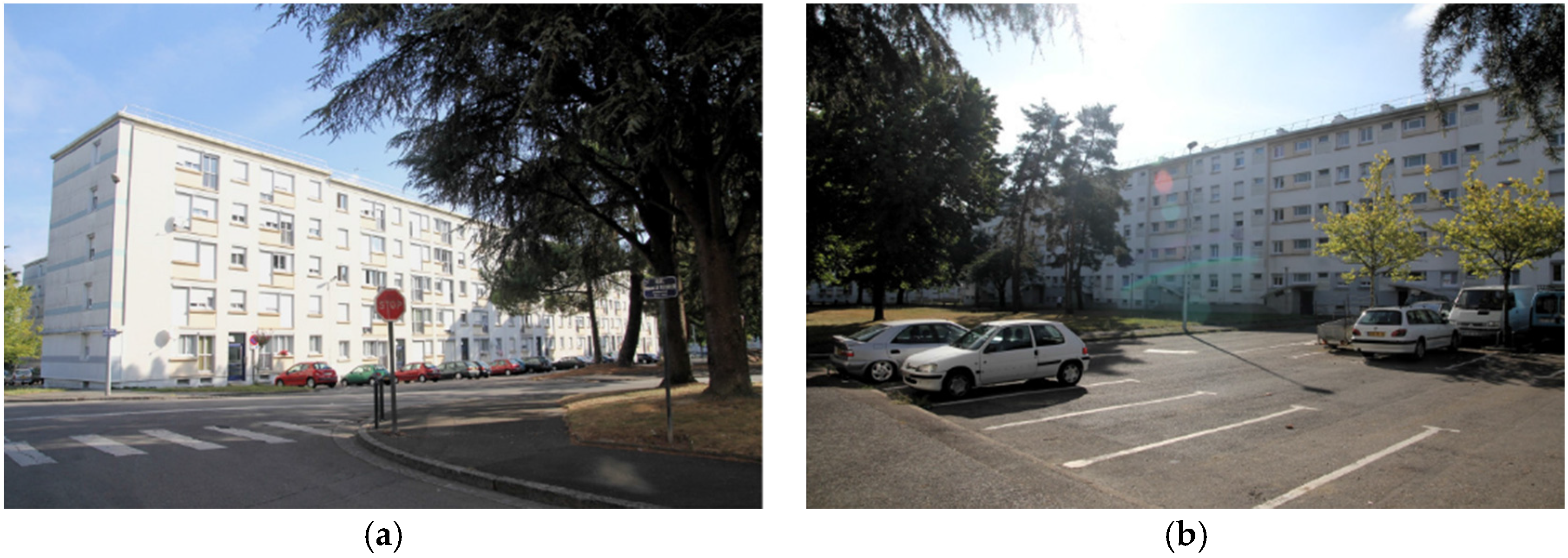
- -
- constant air change rate: Qr = 0.3 vol·h−1;
- -
- constant indoor heat gain: 30 kW.
2.4. Greening Scenario
- -
- architectural greening: green roofs and walls;
- -
- lawns;
- -
- trees;
- -
- sustainable urban drainage systems using vegetation;
- -
- vegetation in deep soil vs. a soilless culture.
- -
- their management: extensive vs. intensive;
- -
- their spatial distribution (city, district or building).
- -
- foliar density: leaf area index (LAI) = 2;
- -
- thickness: L = 0.2 m;
- -
- extinction coefficient: ks = 0.8;
- -
- transmissivity: τf = 0.2;
- -
- an irrigation equal to potential evaporation (PTEc).
2.5. Adaptive Comfort
- high expectations, used solely for spaces occupied by very sensitive and fragile individuals;
- normal expectations, used for new buildings and renovated spaces;
- moderate expectations, used for existing buildings;
- expectation level for buildings outside the first 3 category levels. It is suggested that this category should be used for just a short period of the year.
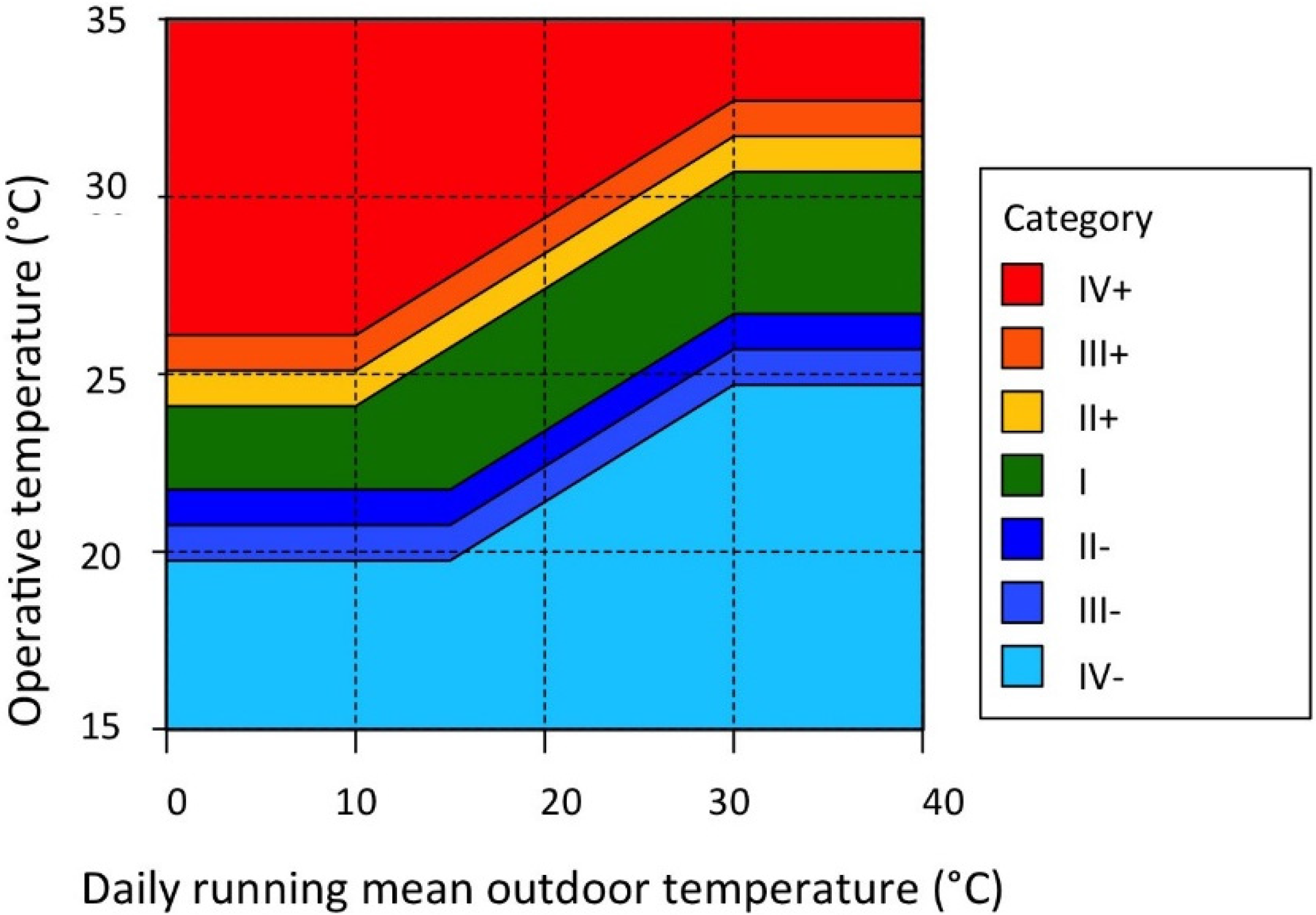
3. Simulations
3.1. Weather Conditions
- -
- outdoor temperature (sensors/Vaisala HMP45C-L, Campbell Scientific, Logan, UT, USA);
- -
- solar radiation (pyranometer Skye SKS 1110, Environmental Measurements Limited, North Shields, UK);
- -
- infrared atmospheric flux (pyrgeometer Kipp&Zonen CGR3, Kipp & Zonen, Delft, The Netherlands);
- -
- wind velocity and direction (wind monitor Young 05103, Young, Traverse City, MI, USA);
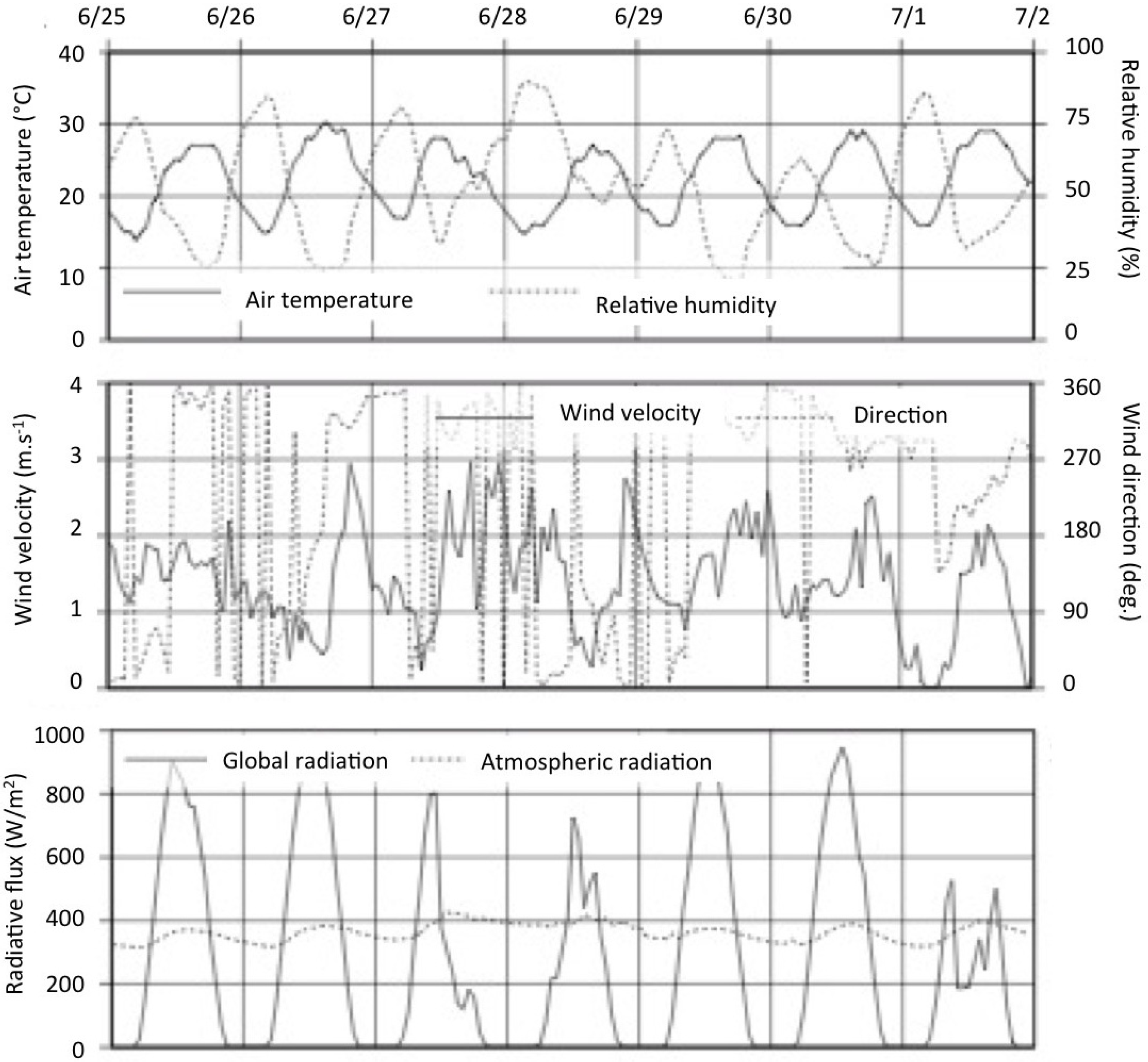
3.2. The Targeted Greening Strategies
- -
- separating direct from indirect effects of the green envelopes;
- -
- comparing the disposal rates.
- -
- facades of the studied building;
- -
- roof on the studied building;
- -
- facades of the other buildings;
- -
- roofs on the other buildings;
- -
- the soil.
- -
- the reference case, without vegetation, or Case (0);
- -
- Cases (1)–(3) are dedicated to assessing the direct effects (only the surfaces on the studied building are greened), with Case (1) being the facades, Case (2) being the roof and Case (3) being both facades and roof;
- -
- Cases (4)–(7) consider just the indirect effects of greening, with Case (4) focusing on the facades, Case (5) focusing on the roofs and Case (6) focusing on the lawns; both the facades and soil are greened in Case (7);
- -
- In Case (8), the entire envelop of the studied building is covered with vegetation, as are the other buildings;
- -
- Cases (0+), (3+), (4+) and (8+) are similar to Cases (0), (3), (4) and (8), respectively, yet with an insulated building; for this insulated building, 10 cm of mineral wool have been added to the internal surface of three walls and the roof.
| Simulation cases | 0 | 0+ | 1 | 2 | 3 | 3+ | 4 | 4+ | 5 | 6 | 7 | 8 | 8+ | |
|---|---|---|---|---|---|---|---|---|---|---|---|---|---|---|
| Effect | Reference | Direct | Indirect | Direct + indirect | ||||||||||
| Building greening | Facades | - | - | X | - | X | X | - | - | - | - | - | X | X |
| Roof | - | - | - | X | X | X | - | - | - | - | - | X | X | |
| Greening of the vicinity | Facades | - | - | - | - | - | - | X | X | - | - | X | X | X |
| Roof | - | - | - | - | - | - | - | - | X | - | - | - | - | |
| Soil | - | - | - | - | - | - | - | - | - | X | X | - | - | |
| +: with an insulated building | - | X | - | - | - | X | - | X | - | - | - | - | X | |
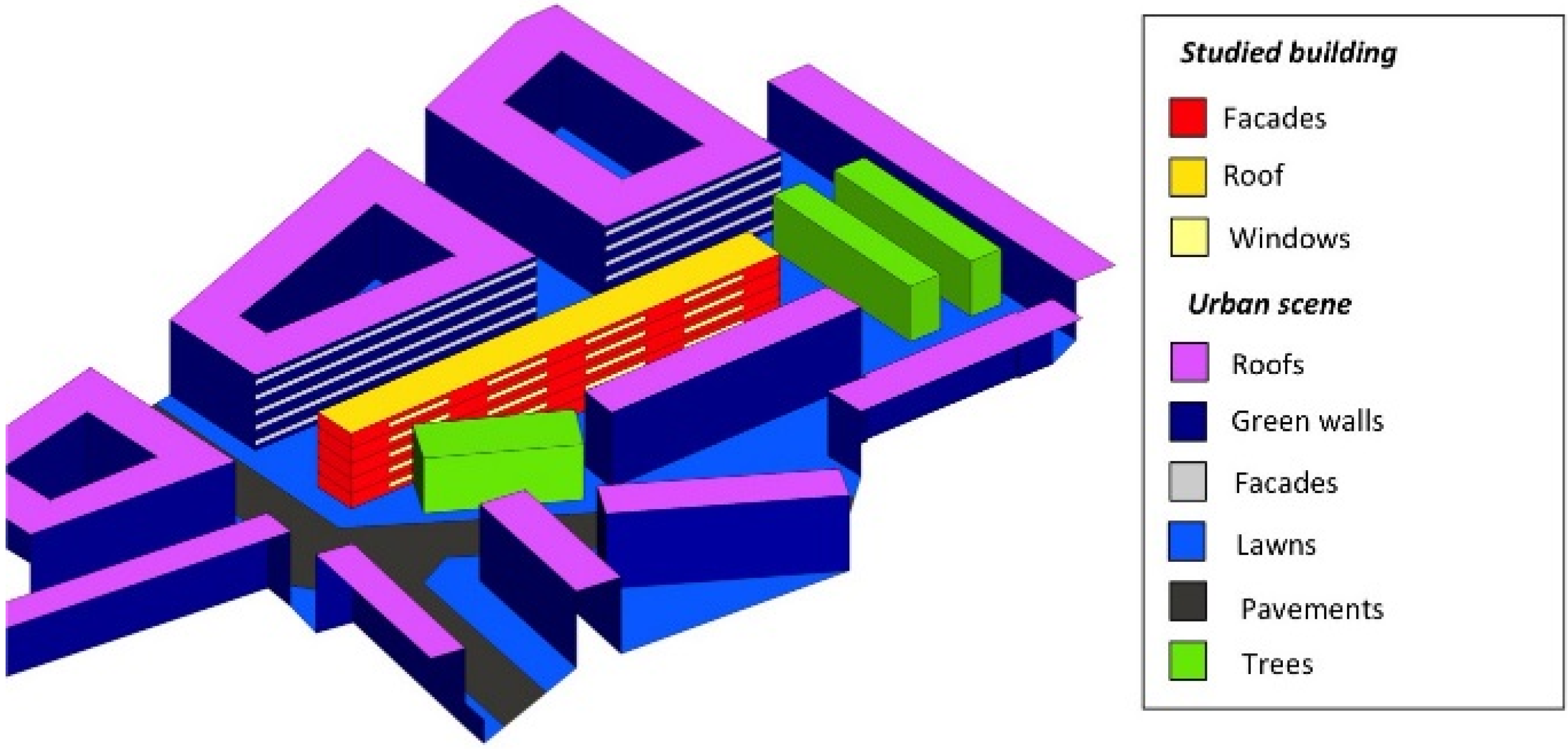
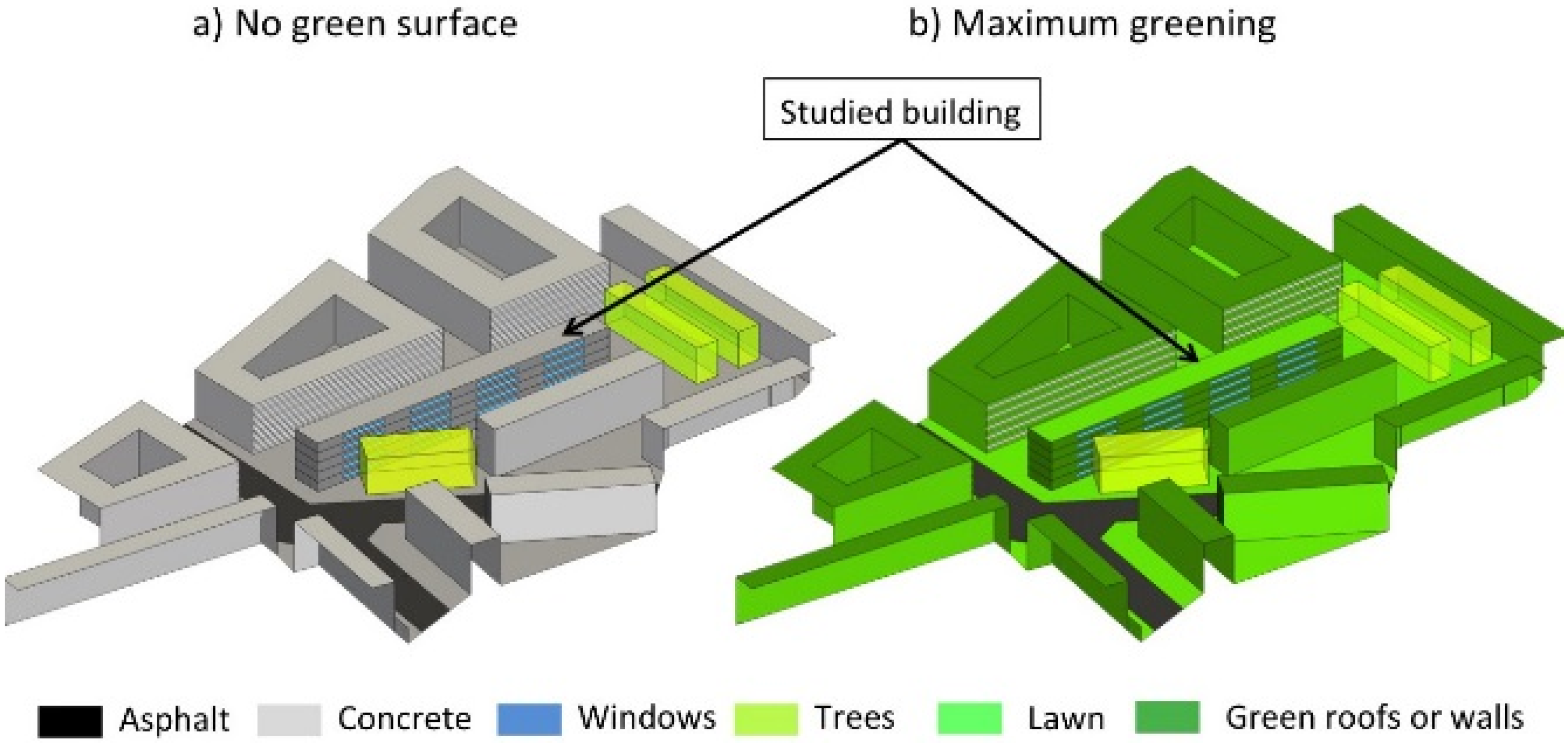
4. Results
- -
- Perspective 1, the effects of vegetation on the thermal insulation level: Cases (0), (3), (4) and (8) for the non-insulated building and Cases (0+), (3+), (4+) and (8+) for the insulated building;
- -
- Perspective 2, comparison of the direct and indirect effects from green walls: Cases (0), (3), (4) and (8);
- -
- Perspective 3, study of the direct effects of green envelopes: Cases (0)–(3);
- -
- Perspective 4, study of the indirect effects of urban green surfaces: Cases (4)–(7).
4.1. Perspective 1: Impact of Green Surfaces on the Thermal Insulation Level
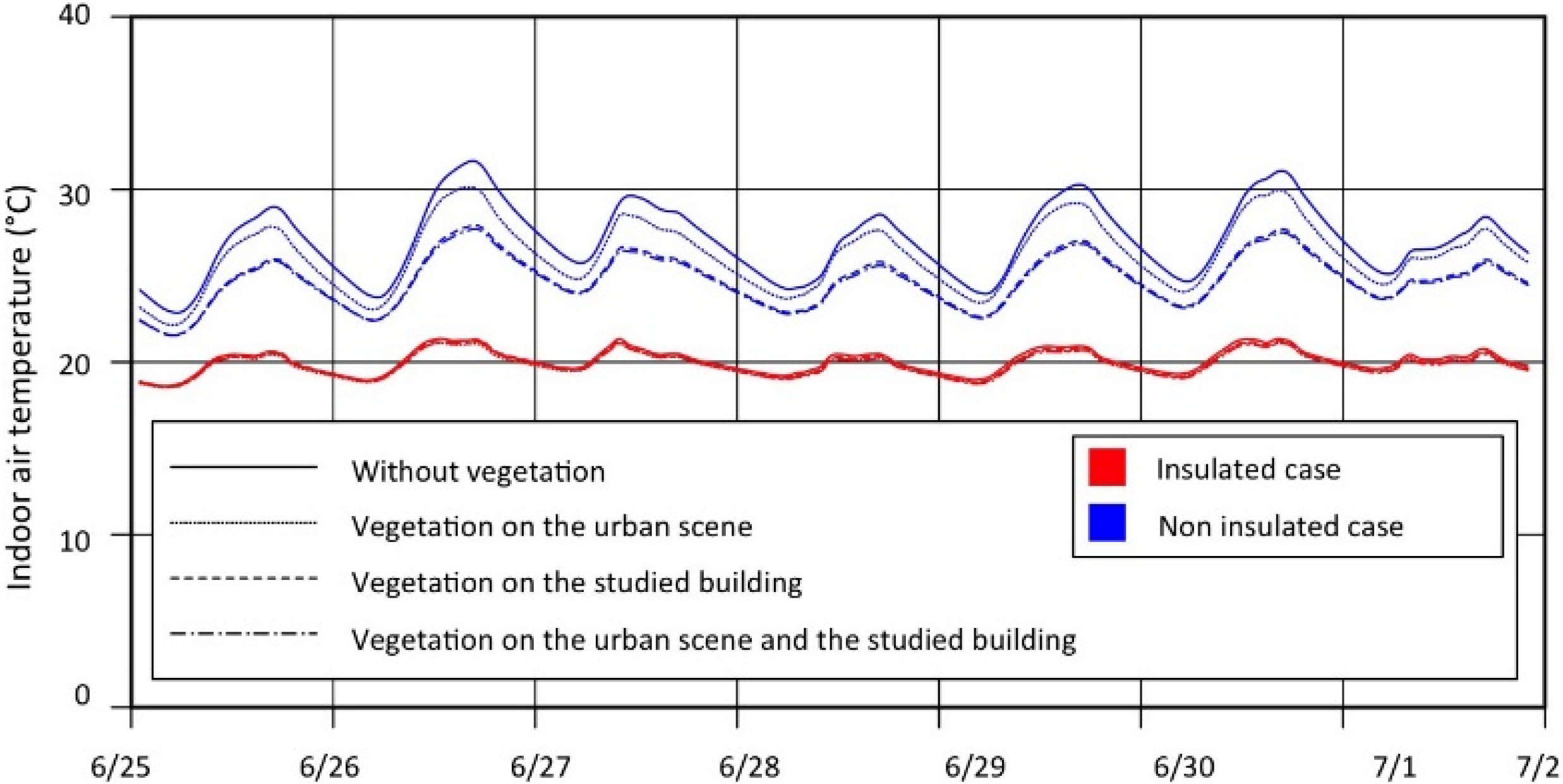
4.2. Perspective 2: Comparison of Direct and Indirect Effects of Green Facades
- -
- the reference case, i.e., without vegetation (0);
- -
- green facades on just the studied building (3);
- -
- green facades on the surrounding buildings, but not on the studied one (4);
- -
- green facades on both the surrounding buildings and the studied one (8).
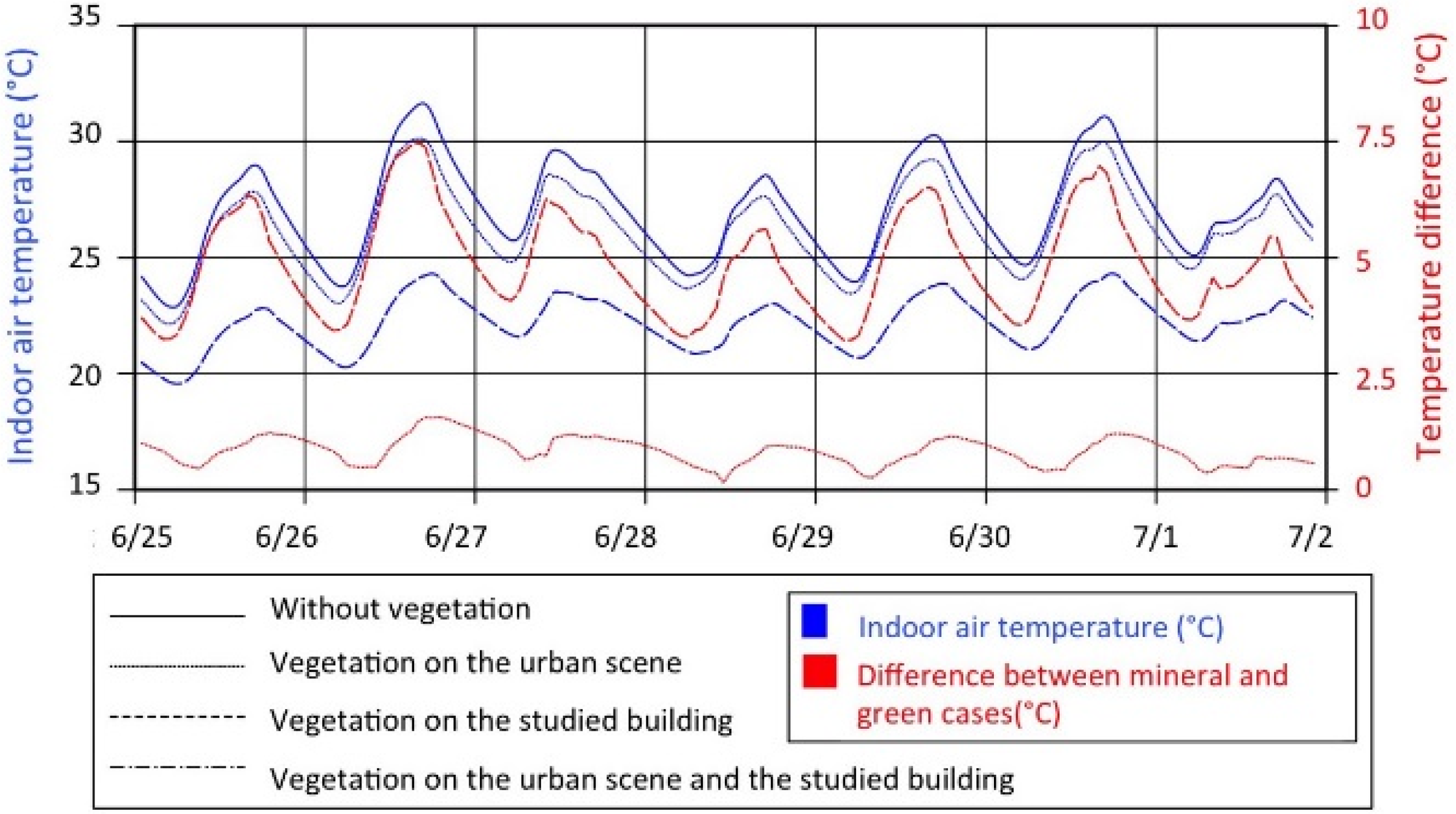
4.2.1. Indoor Air Temperature
4.2.2. Indoor Thermal Comfort
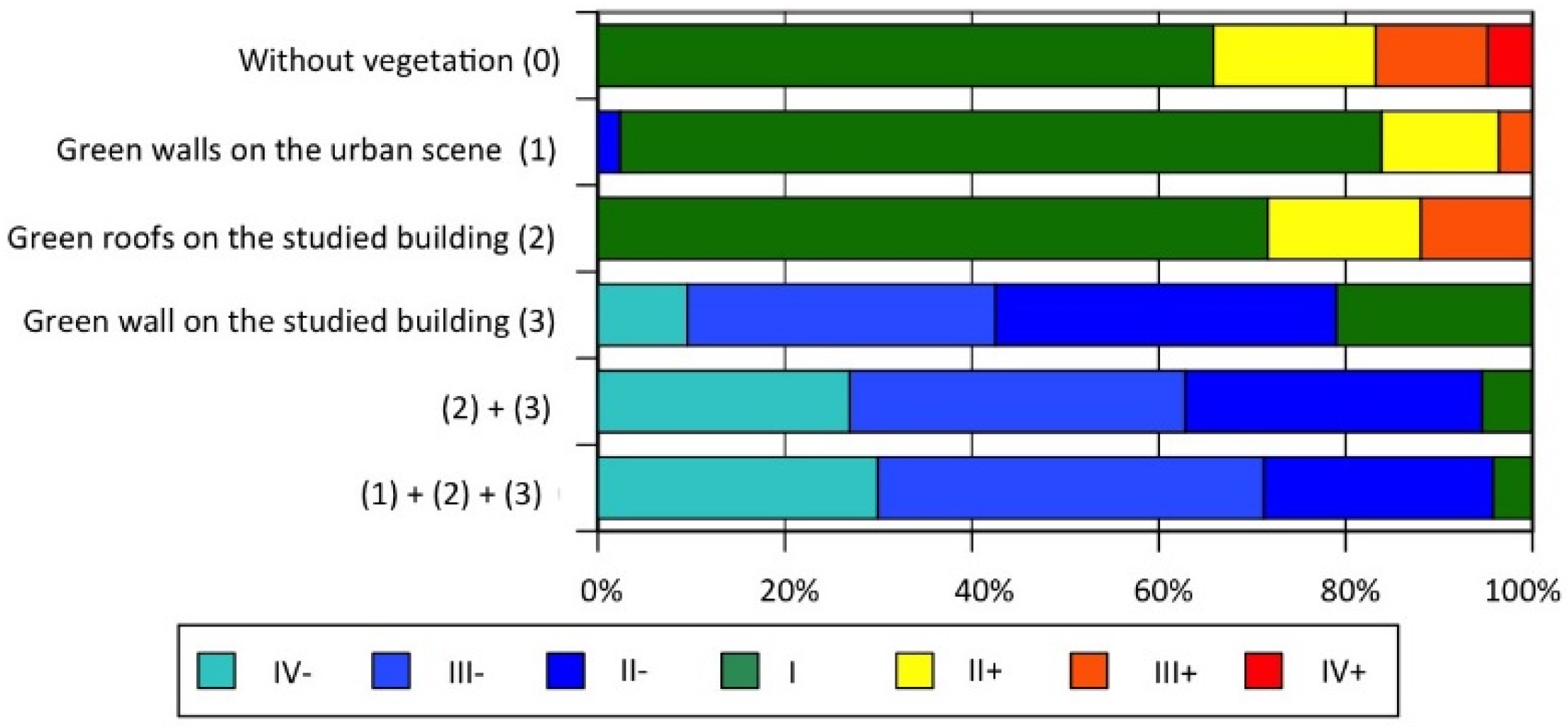
4.2.3. Water Balance
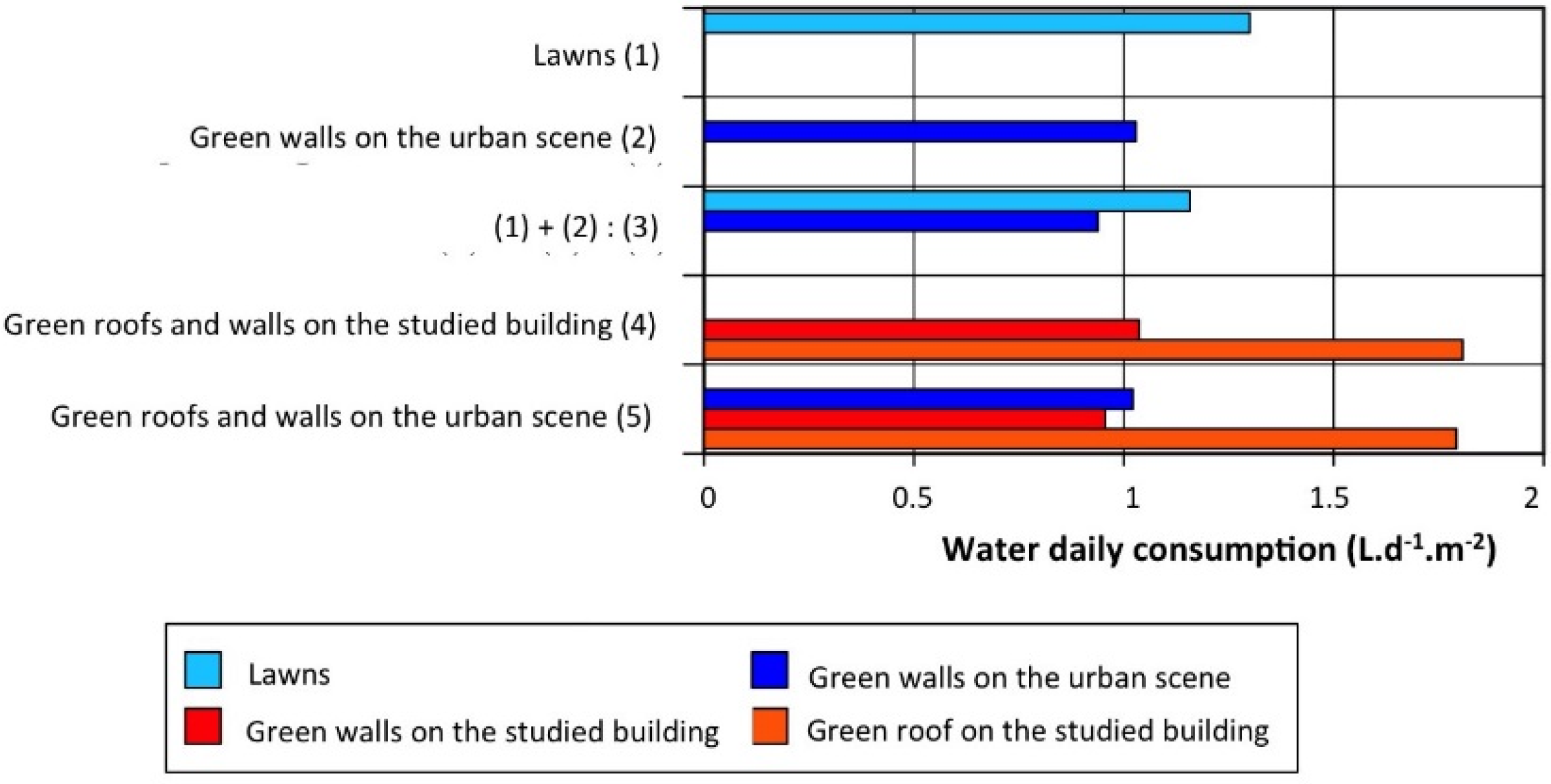
| Configuration | Total Quantity (L) | Footprint (m2) | Total Height of Evaporated Water (mm·m−2) | Evaporation Ratio (%) |
|---|---|---|---|---|
| Green walls on the studied building | 2594 | 954 | 2.72 | 177 |
| Green roof on the studied building | 1723 | 954 | 1.80 | 118 |
| Green walls and roof on the studied building | 4317 | 954 | 4.53 | 195 |
| Green walls in the urban environment | 18,527 | 8012 | 2.31 | 151 |
| Lawns | 15,568 | 13,444 | 1.16 | 75 |
| Total | 38,412 | 23,350 | 1.65 | 107 |
4.3. Perspective 3: Direct Effect of Green Envelopes
4.3.1. Variation of Temperature Inside the Building
- -
- building without any vegetation;
- -
- building with a green roof and green facades;
- -
- an insulated building without vegetation.
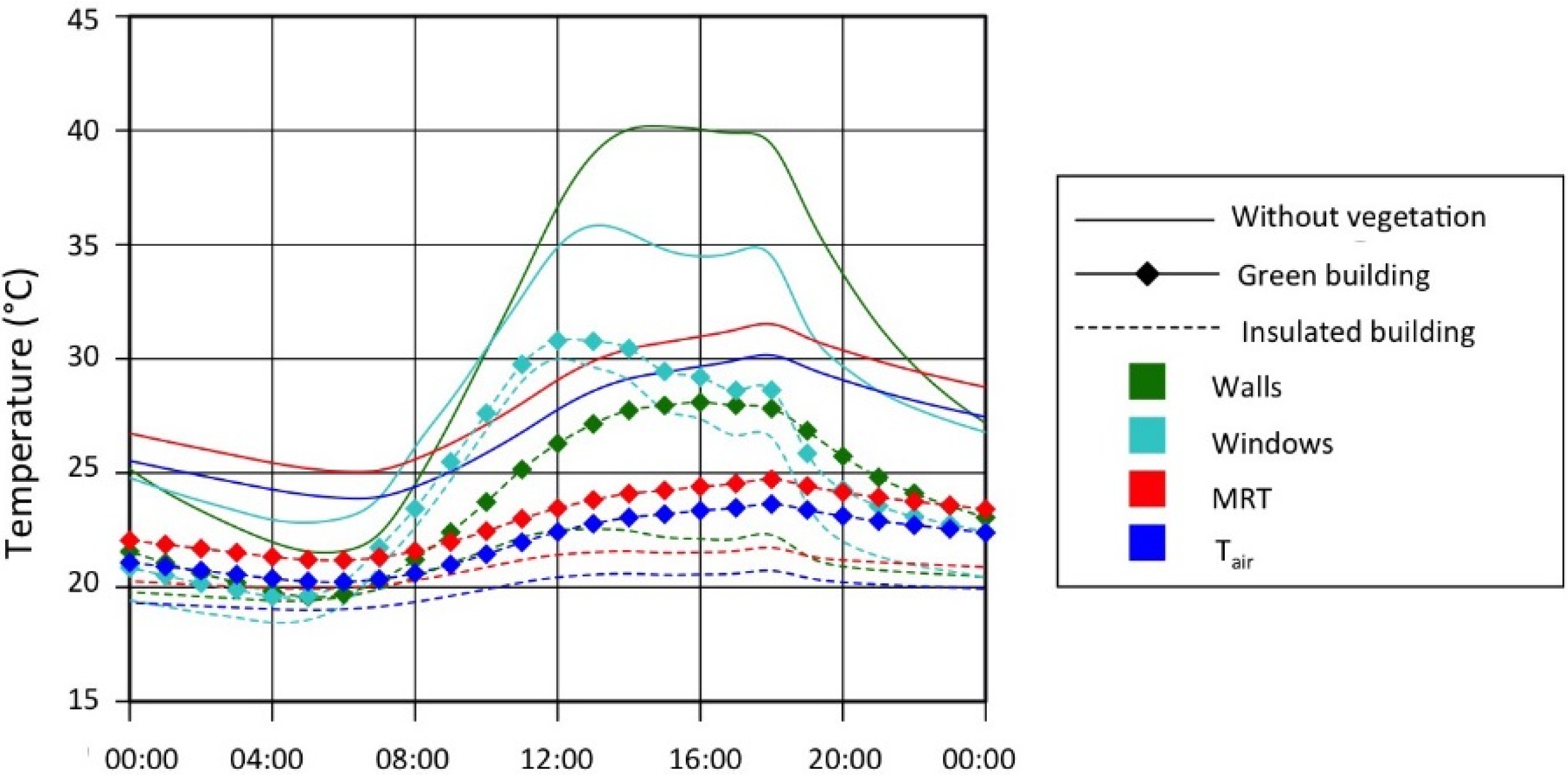
4.3.2. Thermal Fluxes at the External Building Surface
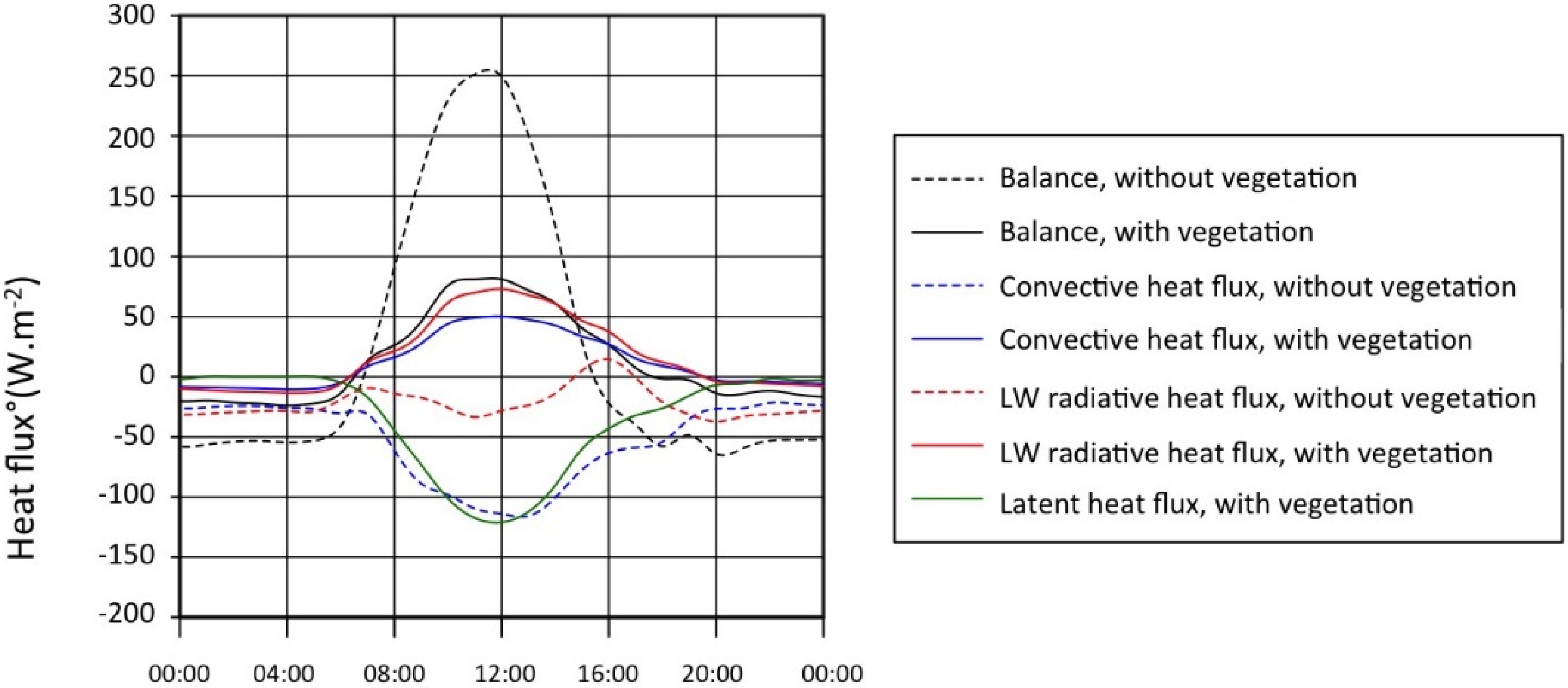
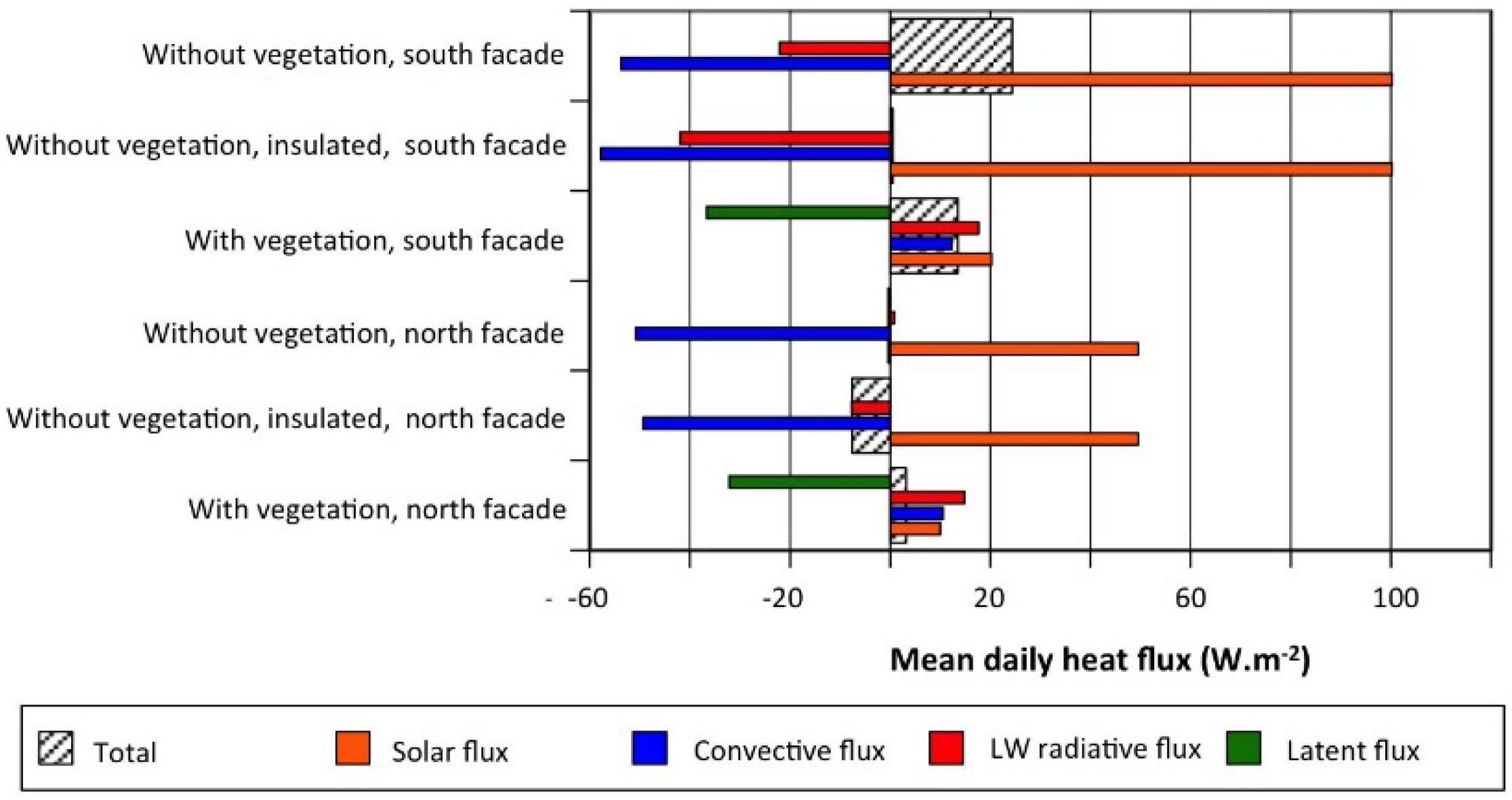
4.4. Perspective 4: Indirect Effects of Vegetation
- -
- To what extent do green roofs modify air temperature in the district and affect the thermal behavior of surrounding buildings?
- -
- What are the impacts of lawns and green walls on the thermal behavior of surrounding buildings?
- -
- Are the direct and indirect effects of these techniques comparable? In particular, what is the predominant effect: convective or radiative?
- -
- the reference case, without vegetation (0);
- -
- a green roof on the studied building (2);
- -
- lawns on the uncovered ground (6);
- -
- lawns and green facades on the studied building and surrounding buildings, (7) + (3).
4.4.1. Indoor Thermal Comfort
- -
- The effect of green roofs is practically negligible;
- -
- The effect of lawns and green walls leads to a decrease in indoor temperature, ranging from 1 °C to 2 °C. This difference slowly varied during the week, with some differences appearing between the configurations after 28 June.
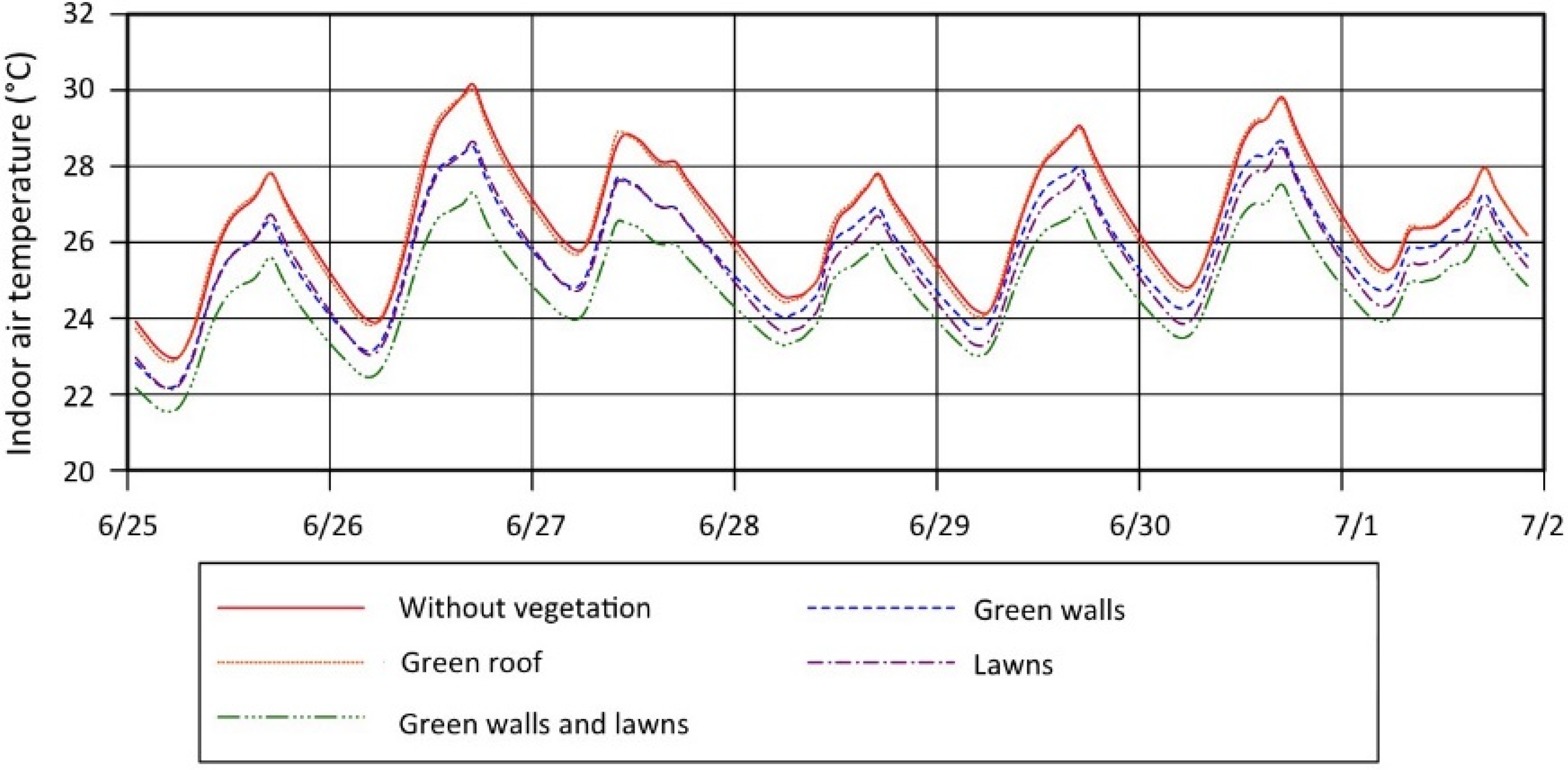
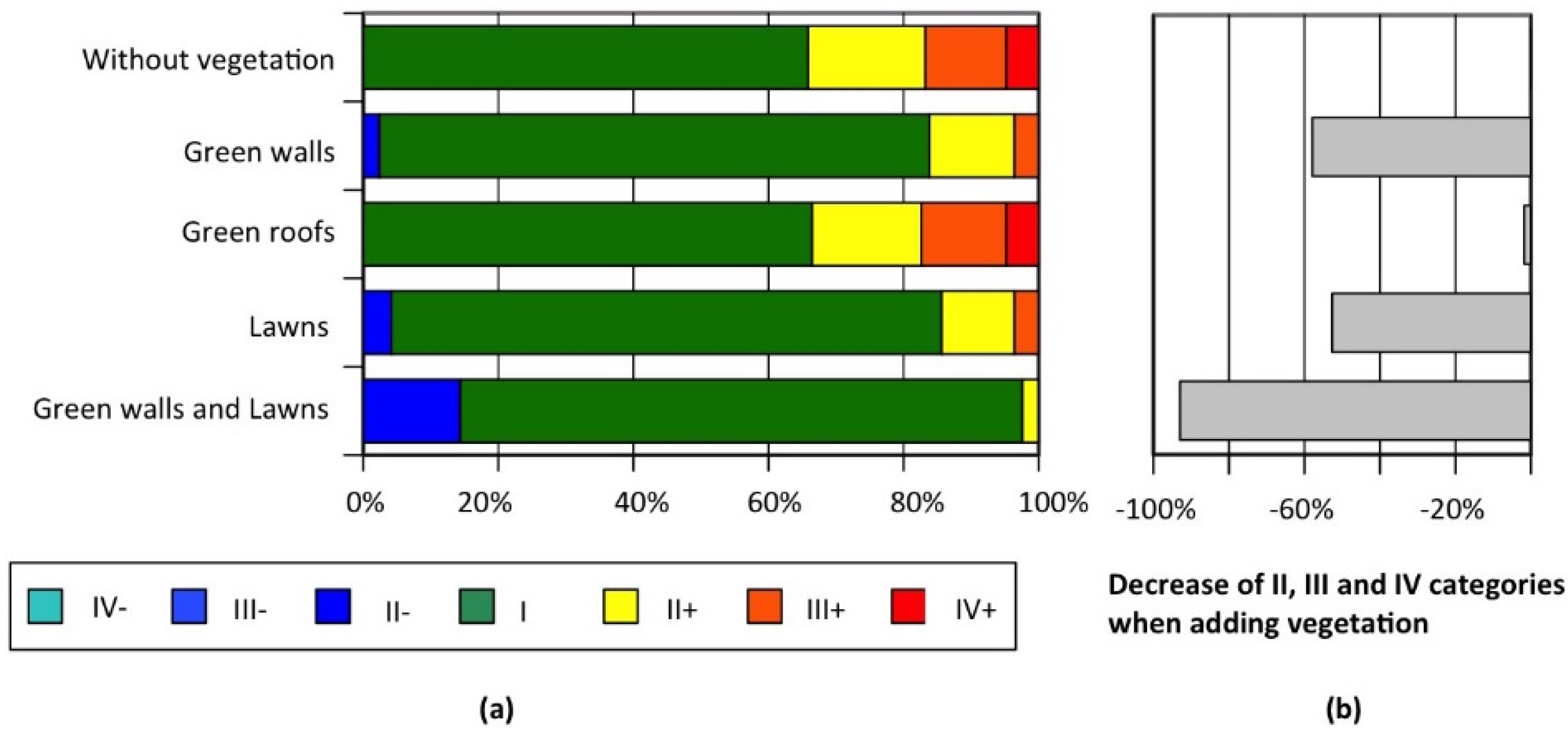
4.4.2. Convective and Radiative Heat Fluxes
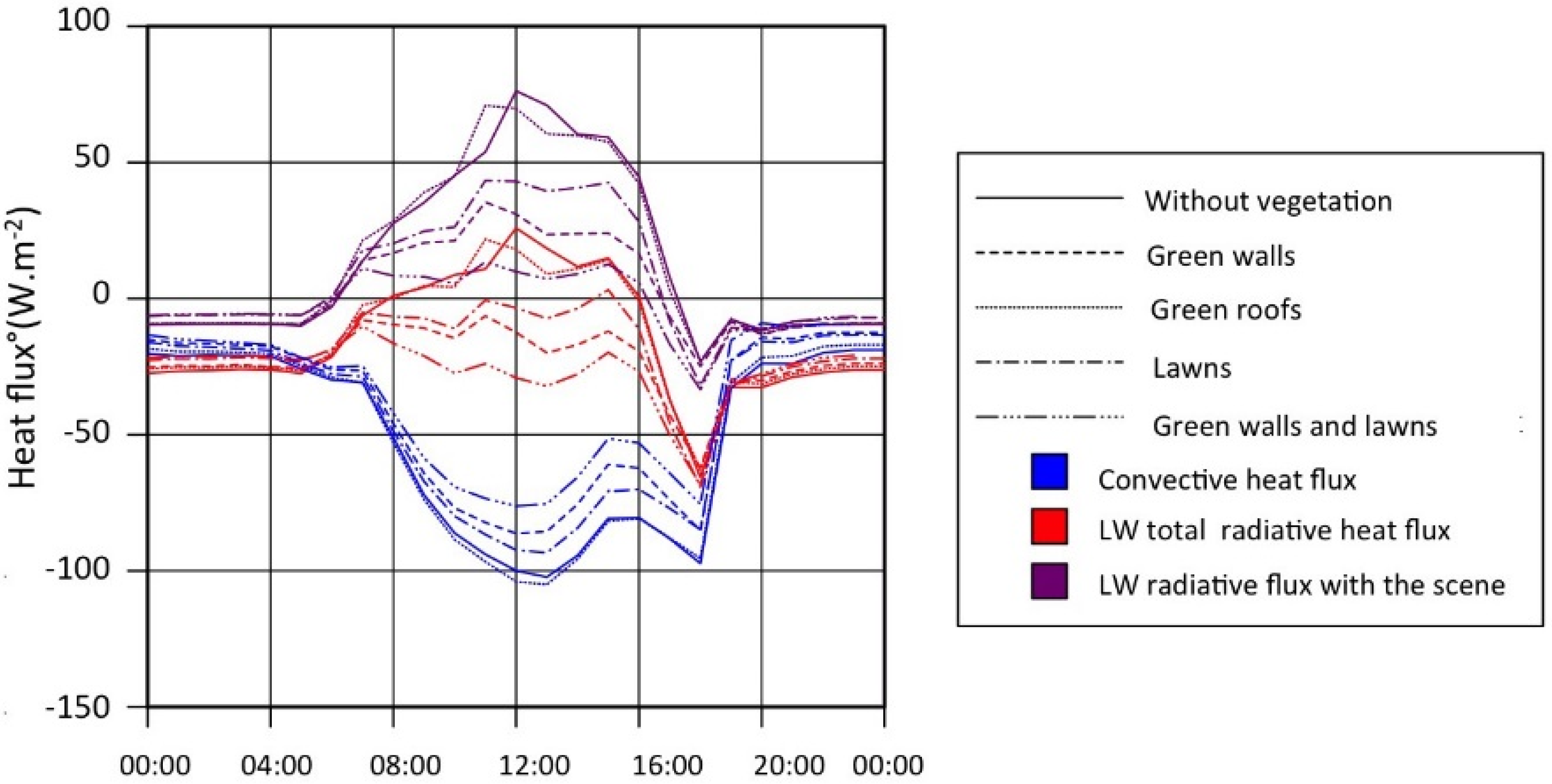
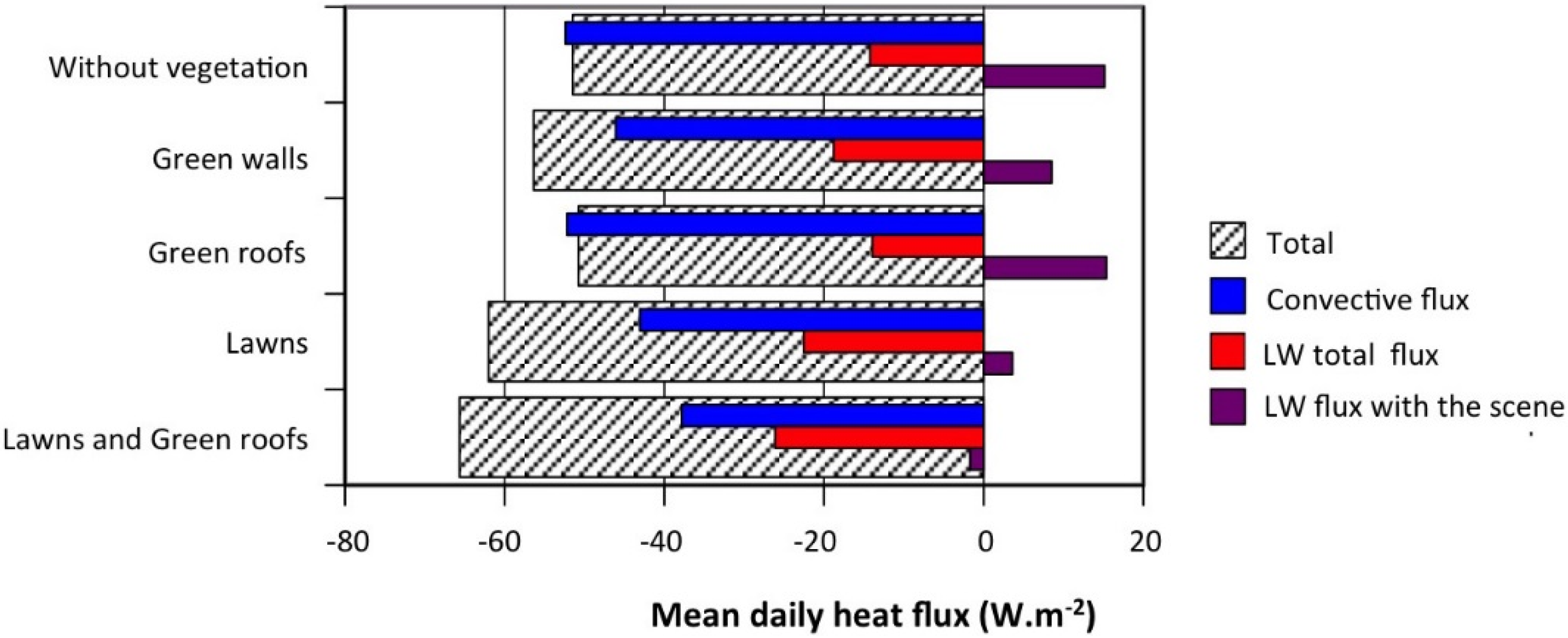
5. Discussion and Conclusions
Acknowledgments
Author Contributions
Conflicts of Interest
References
- Nasir, R.A.; Ahmad, S.S.; Zain-Ahmed, A.; Ibrahim, N. Adapting Human Comfort in an Urban Area: The Role of Tree Shades Towards Urban Regeneration. Proced. Soc. Behav. Sci. 2015, 170, 369–380. [Google Scholar] [CrossRef]
- De Abreu-Harbich, L.V.; Labaki, L.C.; Matzarakis, A. Effect of tree planting design and tree species on human thermal comfort in the tropics. Landsc. Urban Plan. 2015, 138, 99–109. [Google Scholar] [CrossRef]
- Hong, B.; Lin, B. Numerical studies of the outdoor wind environment and thermal comfort at pedestrian level in housing blocks with different building layout patterns and trees arrangement. Renew. Energy 2015, 73, 18–27. [Google Scholar] [CrossRef]
- Vailshery, L.S.; Jaganmohan, M.; Nagendra, H. Effect of street trees on microclimate and air pollution in a tropical city. Urban For. Urban Green. 2013, 12, 408–415. [Google Scholar] [CrossRef]
- Shashua-Bar, L.; Tsiros, I.X.; Hoffman, M.E. A modeling study for evaluating passive cooling scenarios in urban streets with trees. Case study: Athens, Greece. Build. Environ. 2010, 45, 2798–2807. [Google Scholar] [CrossRef]
- Santamouris, M. Cooling the cities—A review of reflective and green roof mitigation technologies to fight heat island and improve comfort in urban environments. Sol. Energy 2014, 103, 682–703. [Google Scholar] [CrossRef]
- Chen, H.; Ookab, R.; Huang, H.; Tsuchiyab, T. Study on mitigation measures for outdoor thermal environment on present urban blocks in Tokyo using coupled simulation. Build. Environ. 2009, 44, 2290–2299. [Google Scholar] [CrossRef]
- Smith, K.; Roeber, P. Green roof mitigation potential for a proxy future climate scenario in Chicago, Illinois. J. Appl. Meteorol. Climatol. 2011, 50, 507–522. [Google Scholar] [CrossRef]
- De Munck, C. Modélisation de la végétation urbaine et stratégies d’adaptation pour l’amélioration du confort climatique et de la demande énergétique en ville. Ph. D. Thesis, University de Toulouse, Toulouse, France, 2013. [Google Scholar]
- Ascione, F.; Bianco, N.; de’ Rossi, F.; Turni, G.; Vanoli, G.P. Green roofs in European climates. Are effective solutions for the energy savings in air-conditioning? Appl. Energy 2013, 104, 845–859. [Google Scholar] [CrossRef]
- Susorova, I.; Angulo, M.; Bahrami, P.; Stephens, B. A model of vegetated exterior facades for evaluation of wall thermal performance. Build. Environ. 2013, 67, 1–13. [Google Scholar] [CrossRef]
- Gros, A. Modélisation de la demande énergétique des bâtiments à l’échelle d’un quartier. Ph.D. Thesis, University de La Rochelle, La Rochelle, France, 2013. [Google Scholar]
- Chen, Q.; Li, B.; Liu, X. An experimental evaluation of the living wall system in hot and humid climate. Energy Build. 2013, 61, 298–307. [Google Scholar] [CrossRef]
- Wong, N.H.; Tan, A.Y.K.; Tan, P.Y.; Wong, N.C. Energy simulation of vertical greenery systems. Energy Build. 2009, 41, 1401–1408. [Google Scholar] [CrossRef]
- Hoyano, A. Climatological uses of plants for solar control and the effects on the thermal environment of a building. Energy Build. 1988, 11, 181–199. [Google Scholar] [CrossRef]
- Cameron, R.W.F.; Taylor, J.E.; Emmett, M.R. What’s “cool” in the world of green facades? How plant choice influences the cooling properties of green walls. Build. Environ. 2014, 73, 198–207. [Google Scholar] [CrossRef]
- Alexandri, E.; Jones, P. Temperature decreases in an urban canyon due to green walls and green roofs in diverse climates. Build. Environ. 2008, 43, 480–493. [Google Scholar] [CrossRef]
- Djedjig, R.; Bozonnet, E.; Belarbi, R. Analysis of thermal effects of vegetated envelopes: Integration of a validated model in a building energy simulation program. Energy Build. 2015, 86, 93–103. [Google Scholar] [CrossRef]
- Armson, D. The Effect of Trees and Grass on the Thermal and Hydrological Performance of an Urban Area. Ph.D. Thesis, University of Manchester, Manchester, UK, 2012. [Google Scholar]
- Akbari, H. Shade trees reduce building energy use and CO2 emissions from power plants. Environ. Pollut. 2002, 116, S119–S126. [Google Scholar] [CrossRef]
- Djedjig, R. Impacts des enveloppes végétales à l’interface bâtiment microclimat urbain. Ph.D. Thesis, University de La Rochelle, La Rochelle, France, 2013. [Google Scholar]
- Malys, L.; Musy, M.; Inard, C. Microclimate and building energy consumption: Study of different coupling methods. Adv. Build. Energy Res. 2015, 9, 151–174. [Google Scholar] [CrossRef]
- Musy, M.; Malys, L.; Morille, B.; Inard, C. The use of SOLENE-microclimat model to assess adaptation strategies at the district scale. Urban Clim. 2015, 14, 213–223. [Google Scholar] [CrossRef]
- Morille, B.; Musy, M.; Malys, L. Preliminary study of the impact of urban greenery types on energy consumption of building at a district scale: Academic study on a canyon street in Nantes (France) weather conditions. Energy Build. 2015. [Google Scholar] [CrossRef]
- Malys, L.; Musy, M.; Inard, C. A hydrothermal model to assess the impact of green walls on urban microclimate and building energy consumption. Build. Environ. 2014, 73, 187–197. [Google Scholar] [CrossRef]
- Bouyer, J.; Inard, C.; Musy, M. Microclimatic coupling as a solution to improve building energy simulation in an urban context. Energy Build. 2011, 43, 1549–1559. [Google Scholar] [CrossRef]
- Bouyer, J. Modélisation et simulation des microclimats urbains—Étude de l’impact de l’aménagement urbain sur les consommations énergétiques des bâtiments. Ph.D. Thesis, Ecole Polytechnique de l’Université de Nantes, Nantes, France, 2009. [Google Scholar]
- Musy, M. VegDUD project: Role of vegetation in sustainable urban development. In Proceedings of the 8th International Conference on Urban Climate and 10th Symposium on the Urban Environment, Dublin, Ireland, 6–10 August 2012.
- Nicol, F.; Humphreys, M.A.; Roaf, S. Adaptive Thermal Comfort: Principles and Practice; Routledge: London, UK; New York, NY, USA, 2012. [Google Scholar]
- Nicol, J.F.; Humphreys, M.A. Adaptive thermal comfort and sustainable thermal standards for buildings. Energy Build. 2002, 34, 563–572. [Google Scholar] [CrossRef]
- NF-EN 15251: Critères d’ambiance intérieure pour la conception et l’évaluation de la performance énergétique des bâtiments couvrant la qualité de l’air intérieure, la thermique, l’éclairage et l’acoustique; AFNOR: La Plaine Saint-Denis, France, 2007. (In French)
- Mestayer, P.; Rosant, J.-M.; Rodriguez, F.; Rouaud, J.-M. The experimental campaign FluxSAP 2010: Climatological measurements over a heterogeneous urban area. Int. Assoc. Urban Clim. 2011, 40, 22–30. [Google Scholar]
© 2016 by the authors; licensee MDPI, Basel, Switzerland. This article is an open access article distributed under the terms and conditions of the Creative Commons by Attribution (CC-BY) license (http://creativecommons.org/licenses/by/4.0/).
Share and Cite
Malys, L.; Musy, M.; Inard, C. Direct and Indirect Impacts of Vegetation on Building Comfort: A Comparative Study of Lawns, Green Walls and Green Roofs. Energies 2016, 9, 32. https://doi.org/10.3390/en9010032
Malys L, Musy M, Inard C. Direct and Indirect Impacts of Vegetation on Building Comfort: A Comparative Study of Lawns, Green Walls and Green Roofs. Energies. 2016; 9(1):32. https://doi.org/10.3390/en9010032
Chicago/Turabian StyleMalys, Laurent, Marjorie Musy, and Christian Inard. 2016. "Direct and Indirect Impacts of Vegetation on Building Comfort: A Comparative Study of Lawns, Green Walls and Green Roofs" Energies 9, no. 1: 32. https://doi.org/10.3390/en9010032
APA StyleMalys, L., Musy, M., & Inard, C. (2016). Direct and Indirect Impacts of Vegetation on Building Comfort: A Comparative Study of Lawns, Green Walls and Green Roofs. Energies, 9(1), 32. https://doi.org/10.3390/en9010032






